Team Cohesion and Work Outcomes: JKL Industries Report
VerifiedAdded on 2021/09/16
|7
|1600
|26
Report
AI Summary
This report analyzes the team effectiveness strategies implemented at JKL Industries. It explores the leadership techniques used by team leaders and managers to facilitate team cohesion and improve work outcomes. The report details the use of planning, organizing, communication, training, and conflict resolution skills. It also examines the methods used for providing feedback, fostering shared understanding, and resolving performance issues. Furthermore, the report outlines the development of policies and procedures to ensure team members take responsibility for their work, including the application of the GROW model. It highlights the importance of performance planning, key performance indicators (KPIs), and two-way communication between teams and management. Finally, the report discusses the process of problem-solving and taking corrective actions to address unresolved issues raised by stakeholders, both internal and external. The report emphasizes the need for identifying problems, gathering information, and implementing effective solutions to improve team performance and achieve organizational goals.
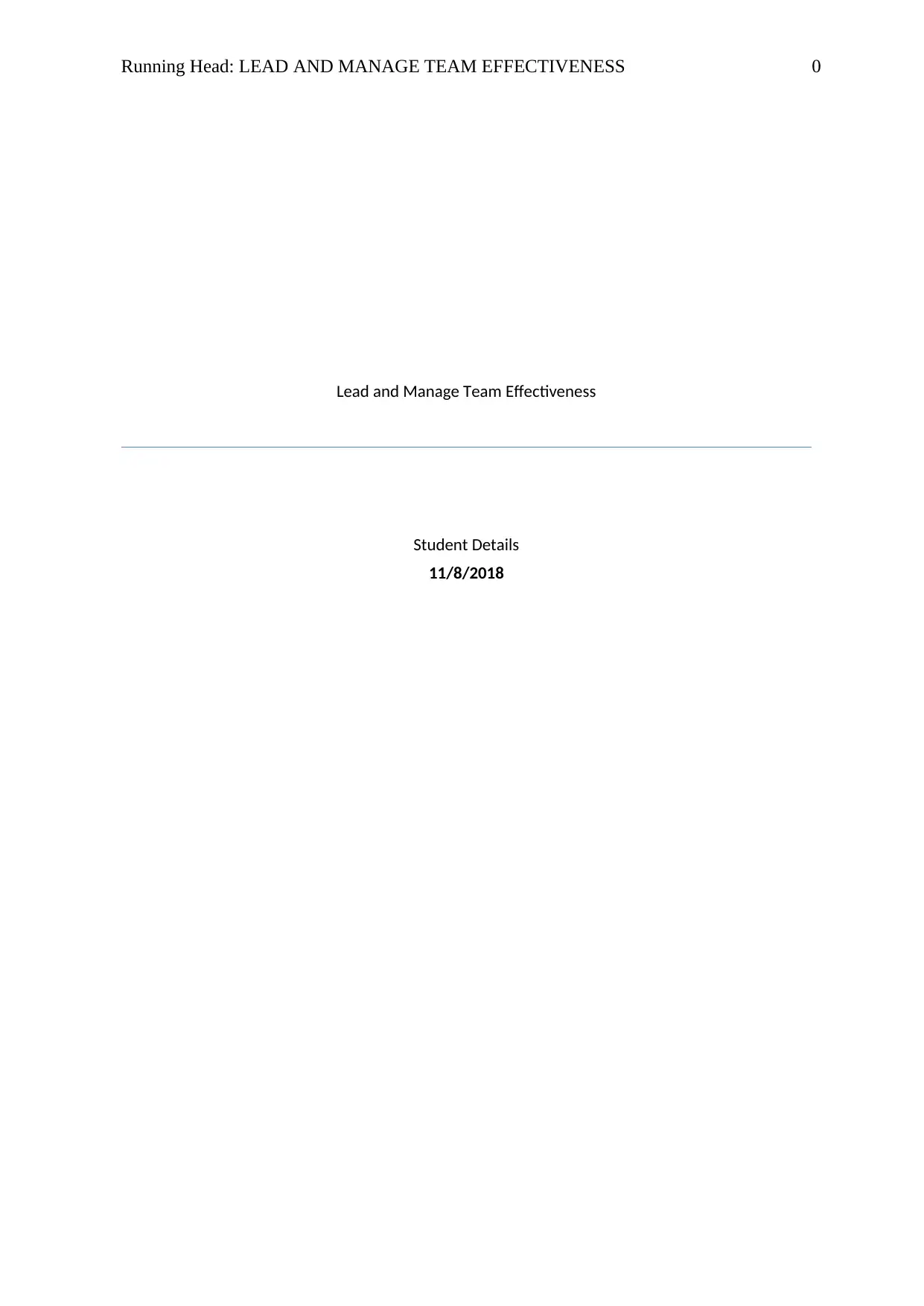
Running Head: LEAD AND MANAGE TEAM EFFECTIVENESS 0
Lead and Manage Team Effectiveness
Student Details
11/8/2018
Lead and Manage Team Effectiveness
Student Details
11/8/2018
Paraphrase This Document
Need a fresh take? Get an instant paraphrase of this document with our AI Paraphraser
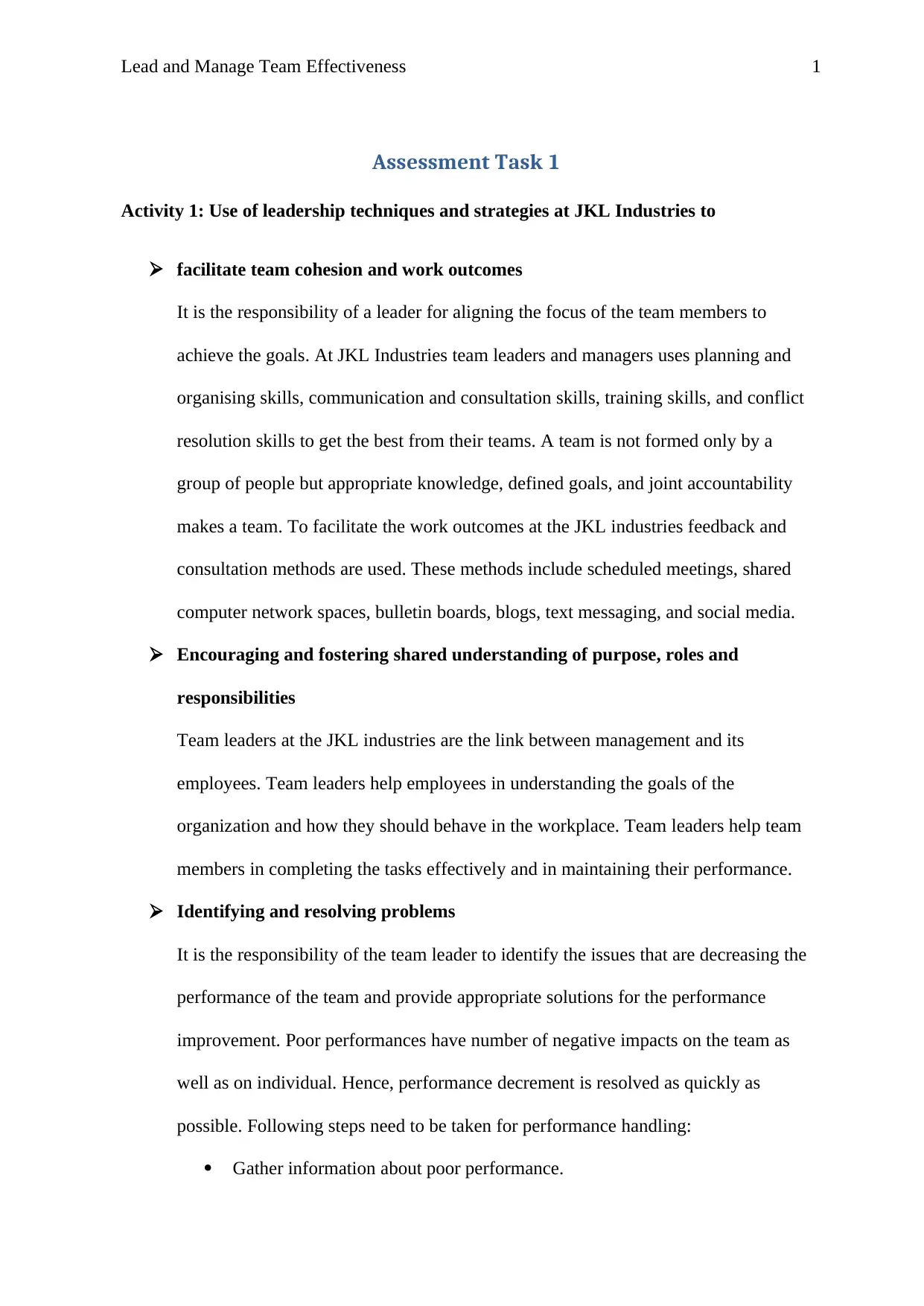
Lead and Manage Team Effectiveness 1
Assessment Task 1
Activity 1: Use of leadership techniques and strategies at JKL Industries to
facilitate team cohesion and work outcomes
It is the responsibility of a leader for aligning the focus of the team members to
achieve the goals. At JKL Industries team leaders and managers uses planning and
organising skills, communication and consultation skills, training skills, and conflict
resolution skills to get the best from their teams. A team is not formed only by a
group of people but appropriate knowledge, defined goals, and joint accountability
makes a team. To facilitate the work outcomes at the JKL industries feedback and
consultation methods are used. These methods include scheduled meetings, shared
computer network spaces, bulletin boards, blogs, text messaging, and social media.
Encouraging and fostering shared understanding of purpose, roles and
responsibilities
Team leaders at the JKL industries are the link between management and its
employees. Team leaders help employees in understanding the goals of the
organization and how they should behave in the workplace. Team leaders help team
members in completing the tasks effectively and in maintaining their performance.
Identifying and resolving problems
It is the responsibility of the team leader to identify the issues that are decreasing the
performance of the team and provide appropriate solutions for the performance
improvement. Poor performances have number of negative impacts on the team as
well as on individual. Hence, performance decrement is resolved as quickly as
possible. Following steps need to be taken for performance handling:
Gather information about poor performance.
Assessment Task 1
Activity 1: Use of leadership techniques and strategies at JKL Industries to
facilitate team cohesion and work outcomes
It is the responsibility of a leader for aligning the focus of the team members to
achieve the goals. At JKL Industries team leaders and managers uses planning and
organising skills, communication and consultation skills, training skills, and conflict
resolution skills to get the best from their teams. A team is not formed only by a
group of people but appropriate knowledge, defined goals, and joint accountability
makes a team. To facilitate the work outcomes at the JKL industries feedback and
consultation methods are used. These methods include scheduled meetings, shared
computer network spaces, bulletin boards, blogs, text messaging, and social media.
Encouraging and fostering shared understanding of purpose, roles and
responsibilities
Team leaders at the JKL industries are the link between management and its
employees. Team leaders help employees in understanding the goals of the
organization and how they should behave in the workplace. Team leaders help team
members in completing the tasks effectively and in maintaining their performance.
Identifying and resolving problems
It is the responsibility of the team leader to identify the issues that are decreasing the
performance of the team and provide appropriate solutions for the performance
improvement. Poor performances have number of negative impacts on the team as
well as on individual. Hence, performance decrement is resolved as quickly as
possible. Following steps need to be taken for performance handling:
Gather information about poor performance.
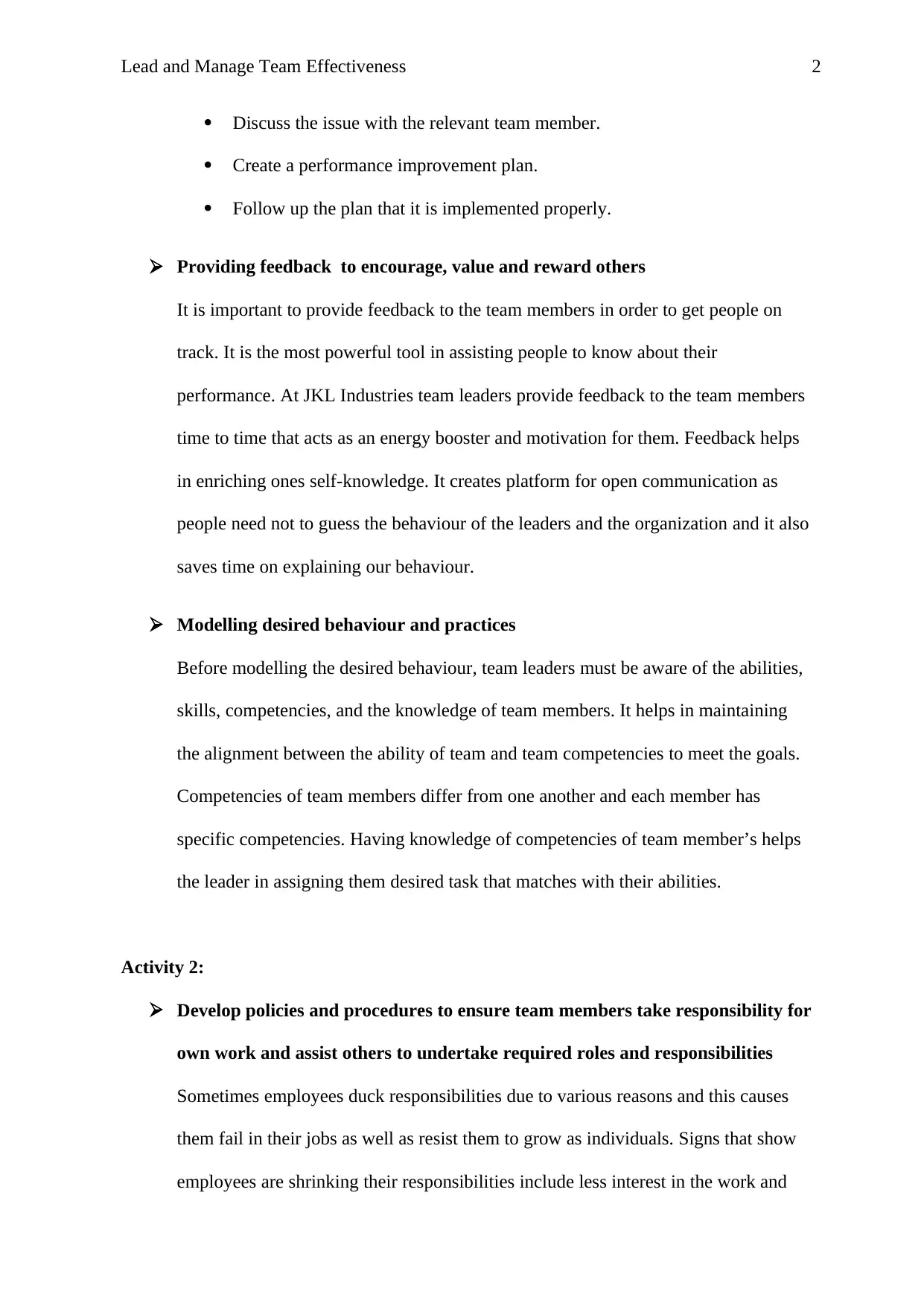
Lead and Manage Team Effectiveness 2
Discuss the issue with the relevant team member.
Create a performance improvement plan.
Follow up the plan that it is implemented properly.
Providing feedback to encourage, value and reward others
It is important to provide feedback to the team members in order to get people on
track. It is the most powerful tool in assisting people to know about their
performance. At JKL Industries team leaders provide feedback to the team members
time to time that acts as an energy booster and motivation for them. Feedback helps
in enriching ones self-knowledge. It creates platform for open communication as
people need not to guess the behaviour of the leaders and the organization and it also
saves time on explaining our behaviour.
Modelling desired behaviour and practices
Before modelling the desired behaviour, team leaders must be aware of the abilities,
skills, competencies, and the knowledge of team members. It helps in maintaining
the alignment between the ability of team and team competencies to meet the goals.
Competencies of team members differ from one another and each member has
specific competencies. Having knowledge of competencies of team member’s helps
the leader in assigning them desired task that matches with their abilities.
Activity 2:
Develop policies and procedures to ensure team members take responsibility for
own work and assist others to undertake required roles and responsibilities
Sometimes employees duck responsibilities due to various reasons and this causes
them fail in their jobs as well as resist them to grow as individuals. Signs that show
employees are shrinking their responsibilities include less interest in the work and
Discuss the issue with the relevant team member.
Create a performance improvement plan.
Follow up the plan that it is implemented properly.
Providing feedback to encourage, value and reward others
It is important to provide feedback to the team members in order to get people on
track. It is the most powerful tool in assisting people to know about their
performance. At JKL Industries team leaders provide feedback to the team members
time to time that acts as an energy booster and motivation for them. Feedback helps
in enriching ones self-knowledge. It creates platform for open communication as
people need not to guess the behaviour of the leaders and the organization and it also
saves time on explaining our behaviour.
Modelling desired behaviour and practices
Before modelling the desired behaviour, team leaders must be aware of the abilities,
skills, competencies, and the knowledge of team members. It helps in maintaining
the alignment between the ability of team and team competencies to meet the goals.
Competencies of team members differ from one another and each member has
specific competencies. Having knowledge of competencies of team member’s helps
the leader in assigning them desired task that matches with their abilities.
Activity 2:
Develop policies and procedures to ensure team members take responsibility for
own work and assist others to undertake required roles and responsibilities
Sometimes employees duck responsibilities due to various reasons and this causes
them fail in their jobs as well as resist them to grow as individuals. Signs that show
employees are shrinking their responsibilities include less interest in the work and
⊘ This is a preview!⊘
Do you want full access?
Subscribe today to unlock all pages.

Trusted by 1+ million students worldwide
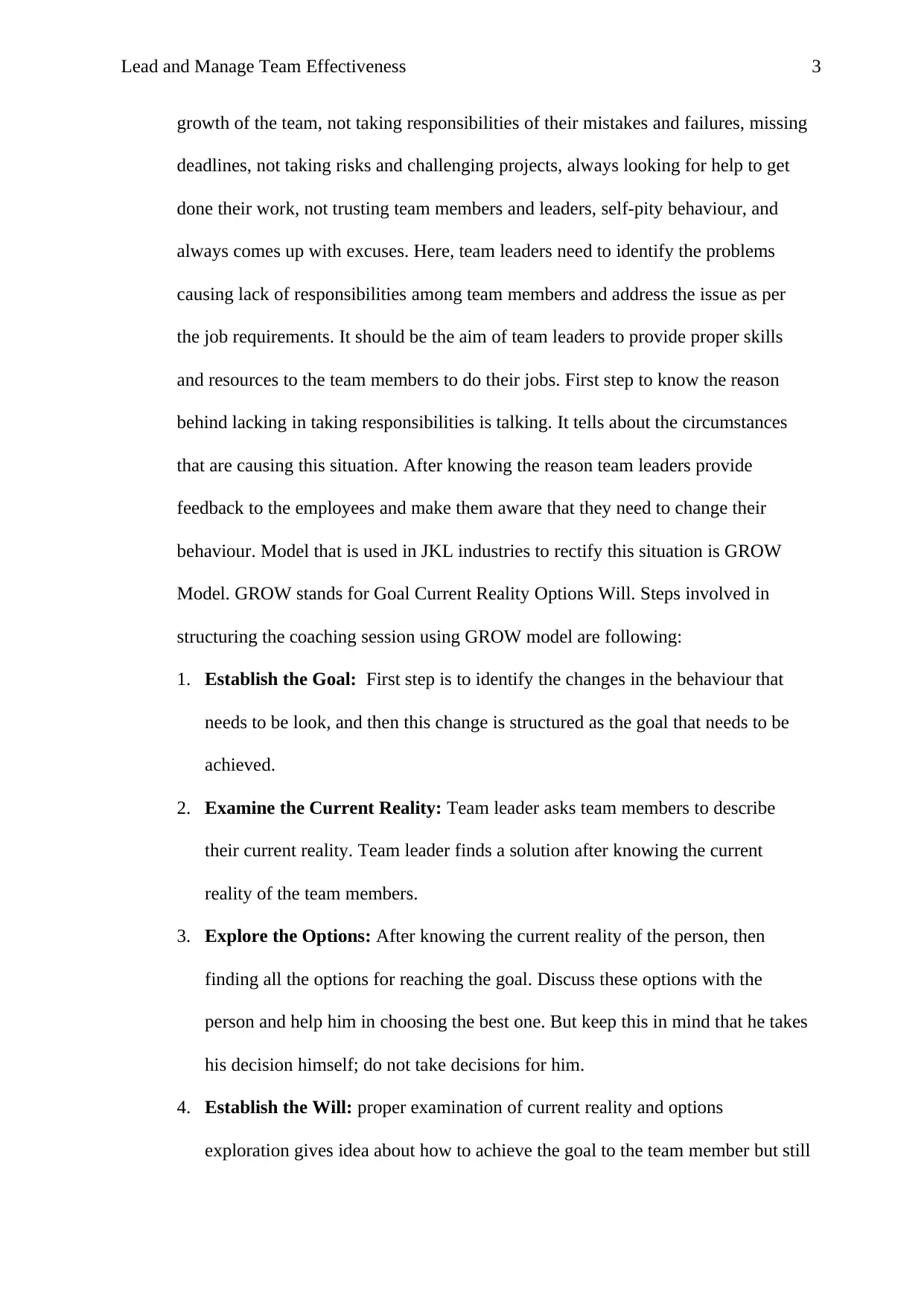
Lead and Manage Team Effectiveness 3
growth of the team, not taking responsibilities of their mistakes and failures, missing
deadlines, not taking risks and challenging projects, always looking for help to get
done their work, not trusting team members and leaders, self-pity behaviour, and
always comes up with excuses. Here, team leaders need to identify the problems
causing lack of responsibilities among team members and address the issue as per
the job requirements. It should be the aim of team leaders to provide proper skills
and resources to the team members to do their jobs. First step to know the reason
behind lacking in taking responsibilities is talking. It tells about the circumstances
that are causing this situation. After knowing the reason team leaders provide
feedback to the employees and make them aware that they need to change their
behaviour. Model that is used in JKL industries to rectify this situation is GROW
Model. GROW stands for Goal Current Reality Options Will. Steps involved in
structuring the coaching session using GROW model are following:
1. Establish the Goal: First step is to identify the changes in the behaviour that
needs to be look, and then this change is structured as the goal that needs to be
achieved.
2. Examine the Current Reality: Team leader asks team members to describe
their current reality. Team leader finds a solution after knowing the current
reality of the team members.
3. Explore the Options: After knowing the current reality of the person, then
finding all the options for reaching the goal. Discuss these options with the
person and help him in choosing the best one. But keep this in mind that he takes
his decision himself; do not take decisions for him.
4. Establish the Will: proper examination of current reality and options
exploration gives idea about how to achieve the goal to the team member but still
growth of the team, not taking responsibilities of their mistakes and failures, missing
deadlines, not taking risks and challenging projects, always looking for help to get
done their work, not trusting team members and leaders, self-pity behaviour, and
always comes up with excuses. Here, team leaders need to identify the problems
causing lack of responsibilities among team members and address the issue as per
the job requirements. It should be the aim of team leaders to provide proper skills
and resources to the team members to do their jobs. First step to know the reason
behind lacking in taking responsibilities is talking. It tells about the circumstances
that are causing this situation. After knowing the reason team leaders provide
feedback to the employees and make them aware that they need to change their
behaviour. Model that is used in JKL industries to rectify this situation is GROW
Model. GROW stands for Goal Current Reality Options Will. Steps involved in
structuring the coaching session using GROW model are following:
1. Establish the Goal: First step is to identify the changes in the behaviour that
needs to be look, and then this change is structured as the goal that needs to be
achieved.
2. Examine the Current Reality: Team leader asks team members to describe
their current reality. Team leader finds a solution after knowing the current
reality of the team members.
3. Explore the Options: After knowing the current reality of the person, then
finding all the options for reaching the goal. Discuss these options with the
person and help him in choosing the best one. But keep this in mind that he takes
his decision himself; do not take decisions for him.
4. Establish the Will: proper examination of current reality and options
exploration gives idea about how to achieve the goal to the team member but still
Paraphrase This Document
Need a fresh take? Get an instant paraphrase of this document with our AI Paraphraser

Lead and Manage Team Effectiveness 4
there is need for motivation and developing Will to move forward in order to
achieve the goals.
Notes to establish processes to address issues and resolve performance issues
Team performance is managed by team leaders in following ways:
1. Ensuring team contributes positively: There are three criteria that decide the
positive contribution of the team. Team leaders should have understanding of the
team performance, link between the task completed by each team member, and
the business plan of the organization, targets of the team performance, and
appropriate process of communicating with team members about the task.
2. Encouraging the team to use initiative and to be innovative: At JKL, team leaders
encourage the team members in the industry by making them ensured that their
ideas and suggestions are always welcomed and appreciated in the company.
Innovation and use of initiative are linked with risk taking and should not be
misunderstood with unsafe behaviour. Innovation describes the opportunities
provided to the team members to offer new ideas for completing the task.
Activity 4:
Team performance plans and team performance
To attain the desired level of performance for both teams and individuals,
performance planning is used. Performance planning is a structured approach to
attain the desired performance. Team leader’s role is to develop a performance plan
in conjunction with the performance plan of manager. An organization’s or
individual’s success is measured using Key Performance Indicators (KPIs).
Performance planning is occurred as:
there is need for motivation and developing Will to move forward in order to
achieve the goals.
Notes to establish processes to address issues and resolve performance issues
Team performance is managed by team leaders in following ways:
1. Ensuring team contributes positively: There are three criteria that decide the
positive contribution of the team. Team leaders should have understanding of the
team performance, link between the task completed by each team member, and
the business plan of the organization, targets of the team performance, and
appropriate process of communicating with team members about the task.
2. Encouraging the team to use initiative and to be innovative: At JKL, team leaders
encourage the team members in the industry by making them ensured that their
ideas and suggestions are always welcomed and appreciated in the company.
Innovation and use of initiative are linked with risk taking and should not be
misunderstood with unsafe behaviour. Innovation describes the opportunities
provided to the team members to offer new ideas for completing the task.
Activity 4:
Team performance plans and team performance
To attain the desired level of performance for both teams and individuals,
performance planning is used. Performance planning is a structured approach to
attain the desired performance. Team leader’s role is to develop a performance plan
in conjunction with the performance plan of manager. An organization’s or
individual’s success is measured using Key Performance Indicators (KPIs).
Performance planning is occurred as:

Lead and Manage Team Effectiveness 5
1. Initial Performance Plan: It is a detailed plan which is used for the identification
of desired performance levels, methods to achieve these performance levels,
direction and guidance providence, and measuring progress for achieving the
desired performance levels.
2. Performance Improvement Plan: Following steps are needed to take in case of
performance deficiency:
Gather information regarding lower performance.
Discuss the issue with relevant member.
Create a performance improvement plan.
Follow up.
Ways to facilitate two-way flow of information between team and management
relevant to team performance
Performance plan is developed by effectively discussing performance planning. And
the two way discussion on performance planning is the most effective way. At JKL
industries team leader and the manger discuss about the plans for the performance
improvement. A two-way discussion wants both the people prepared beforehand.
Steps involved in a two-way discussion are:
Prepare for the discussion: it includes document that provide information
about one’s role such as job description, strategic plans, and business plan. It
also tells about what someone wants to discuss. It also includes selecting a
time and place for the discussion that suits both the people.
During the discussion: It requires honest communication, being respectful,
positive approach and keeping focus on the future, real and reasonable
expectations from each other.
1. Initial Performance Plan: It is a detailed plan which is used for the identification
of desired performance levels, methods to achieve these performance levels,
direction and guidance providence, and measuring progress for achieving the
desired performance levels.
2. Performance Improvement Plan: Following steps are needed to take in case of
performance deficiency:
Gather information regarding lower performance.
Discuss the issue with relevant member.
Create a performance improvement plan.
Follow up.
Ways to facilitate two-way flow of information between team and management
relevant to team performance
Performance plan is developed by effectively discussing performance planning. And
the two way discussion on performance planning is the most effective way. At JKL
industries team leader and the manger discuss about the plans for the performance
improvement. A two-way discussion wants both the people prepared beforehand.
Steps involved in a two-way discussion are:
Prepare for the discussion: it includes document that provide information
about one’s role such as job description, strategic plans, and business plan. It
also tells about what someone wants to discuss. It also includes selecting a
time and place for the discussion that suits both the people.
During the discussion: It requires honest communication, being respectful,
positive approach and keeping focus on the future, real and reasonable
expectations from each other.
⊘ This is a preview!⊘
Do you want full access?
Subscribe today to unlock all pages.

Trusted by 1+ million students worldwide
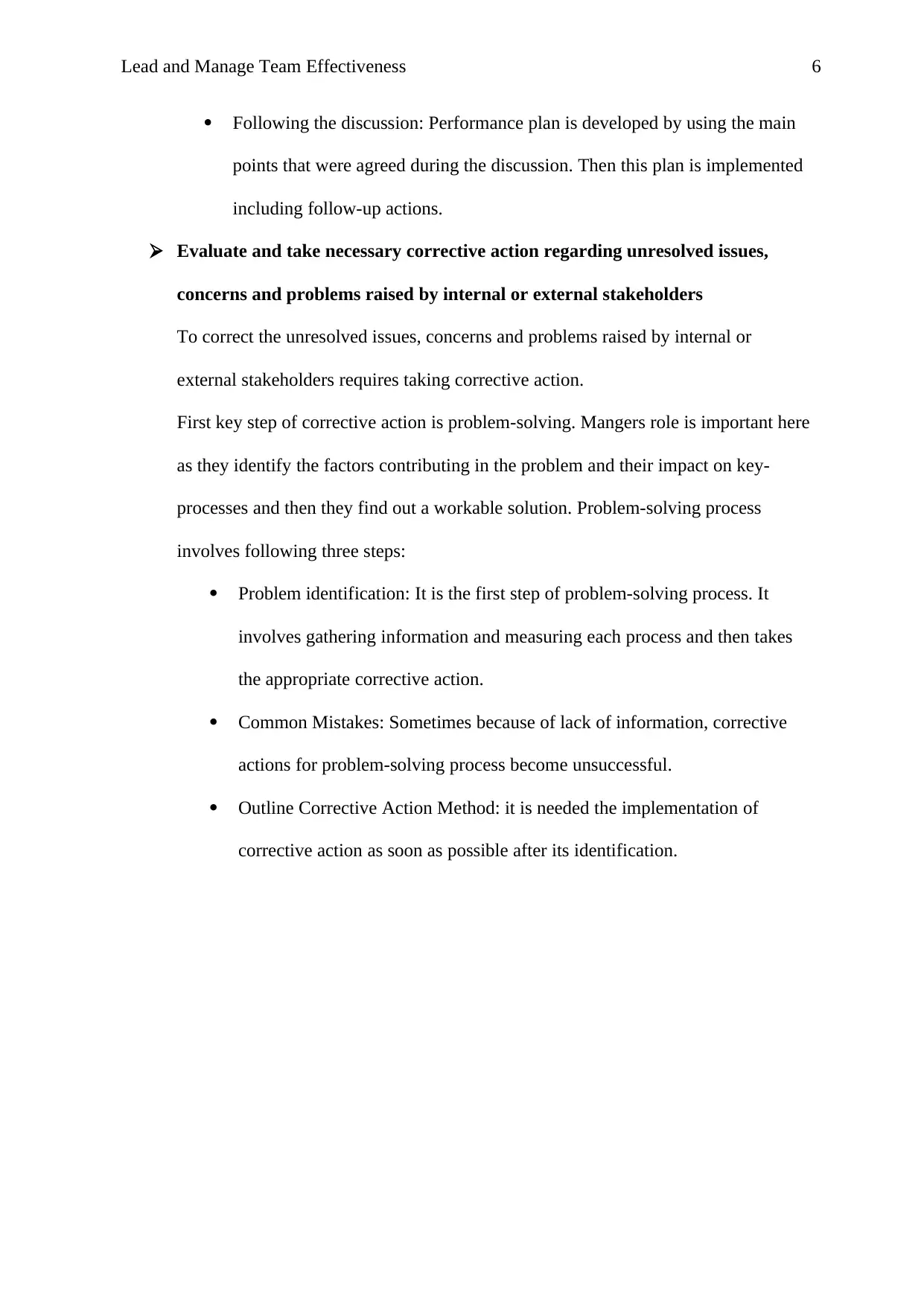
Lead and Manage Team Effectiveness 6
Following the discussion: Performance plan is developed by using the main
points that were agreed during the discussion. Then this plan is implemented
including follow-up actions.
Evaluate and take necessary corrective action regarding unresolved issues,
concerns and problems raised by internal or external stakeholders
To correct the unresolved issues, concerns and problems raised by internal or
external stakeholders requires taking corrective action.
First key step of corrective action is problem-solving. Mangers role is important here
as they identify the factors contributing in the problem and their impact on key-
processes and then they find out a workable solution. Problem-solving process
involves following three steps:
Problem identification: It is the first step of problem-solving process. It
involves gathering information and measuring each process and then takes
the appropriate corrective action.
Common Mistakes: Sometimes because of lack of information, corrective
actions for problem-solving process become unsuccessful.
Outline Corrective Action Method: it is needed the implementation of
corrective action as soon as possible after its identification.
Following the discussion: Performance plan is developed by using the main
points that were agreed during the discussion. Then this plan is implemented
including follow-up actions.
Evaluate and take necessary corrective action regarding unresolved issues,
concerns and problems raised by internal or external stakeholders
To correct the unresolved issues, concerns and problems raised by internal or
external stakeholders requires taking corrective action.
First key step of corrective action is problem-solving. Mangers role is important here
as they identify the factors contributing in the problem and their impact on key-
processes and then they find out a workable solution. Problem-solving process
involves following three steps:
Problem identification: It is the first step of problem-solving process. It
involves gathering information and measuring each process and then takes
the appropriate corrective action.
Common Mistakes: Sometimes because of lack of information, corrective
actions for problem-solving process become unsuccessful.
Outline Corrective Action Method: it is needed the implementation of
corrective action as soon as possible after its identification.
1 out of 7
Related Documents
Your All-in-One AI-Powered Toolkit for Academic Success.
+13062052269
info@desklib.com
Available 24*7 on WhatsApp / Email
![[object Object]](/_next/static/media/star-bottom.7253800d.svg)
Unlock your academic potential
Copyright © 2020–2025 A2Z Services. All Rights Reserved. Developed and managed by ZUCOL.




